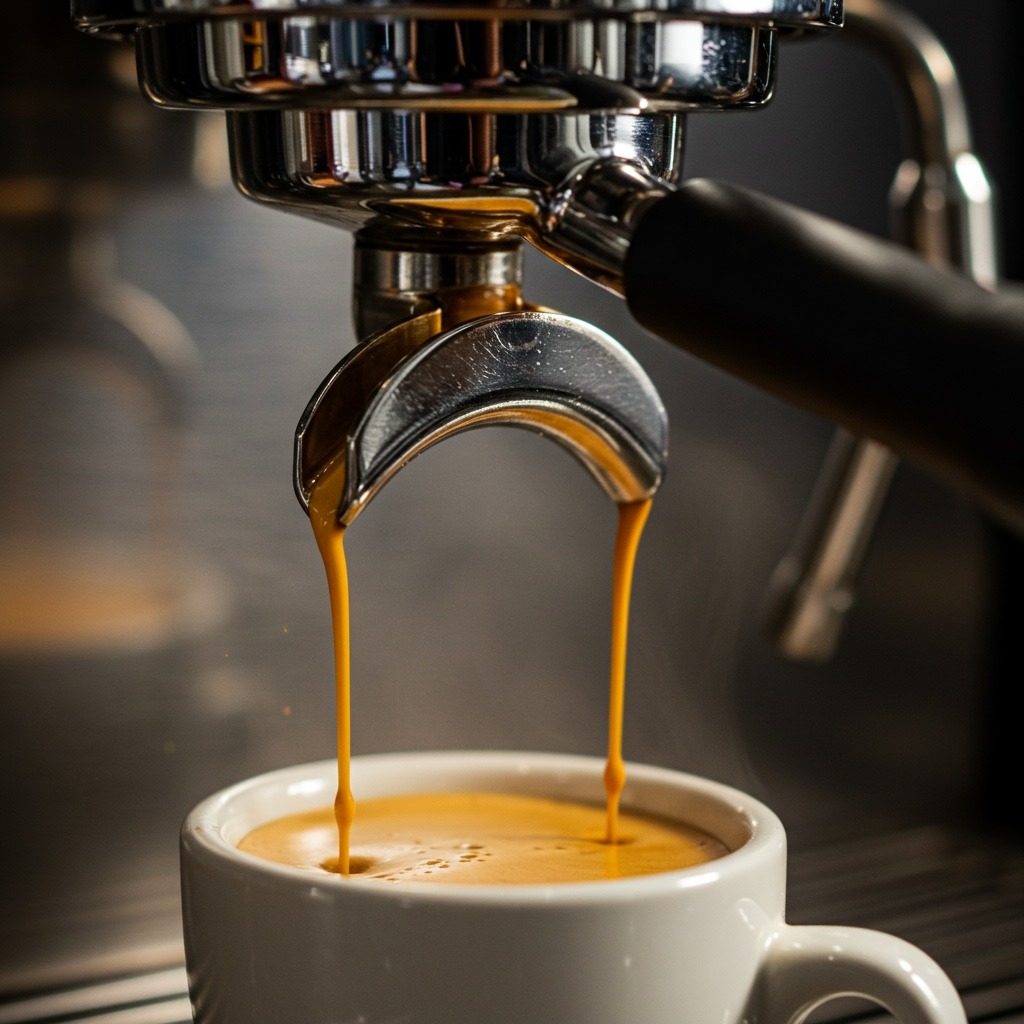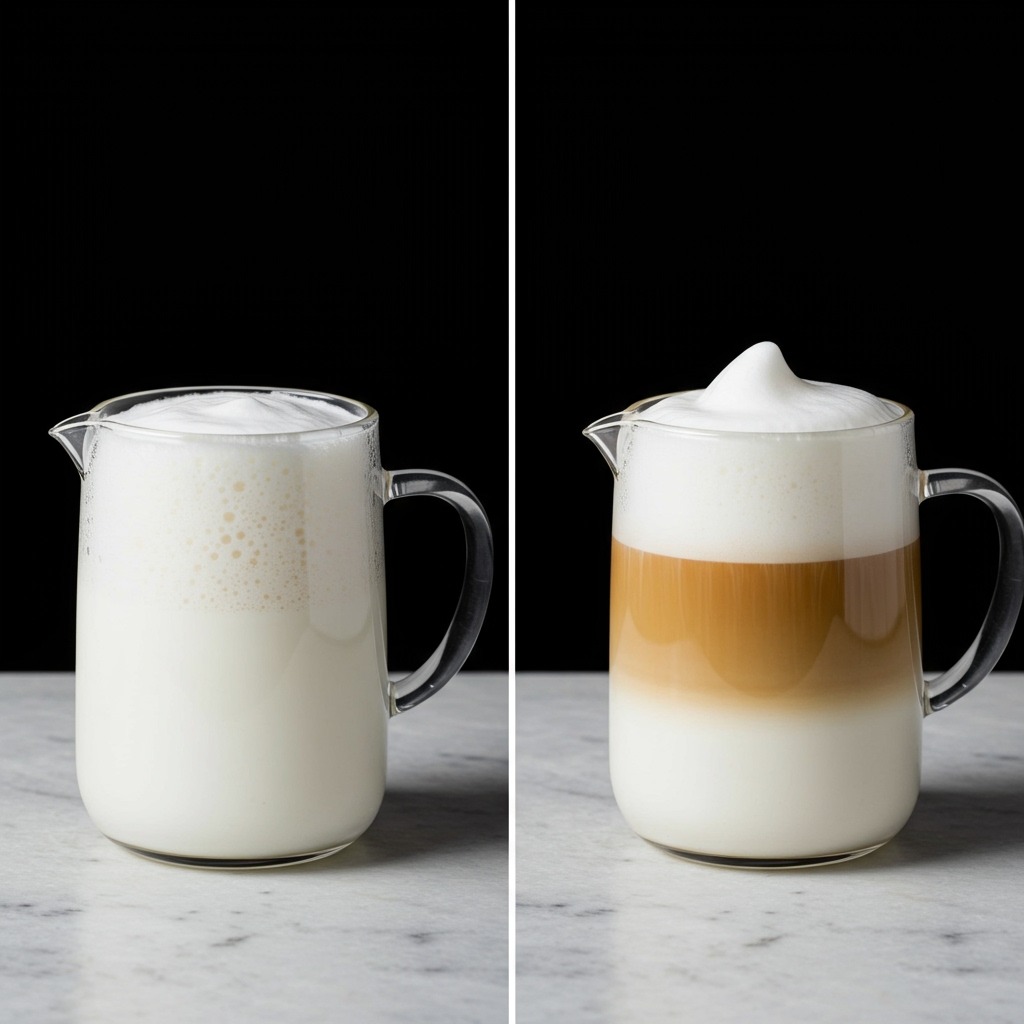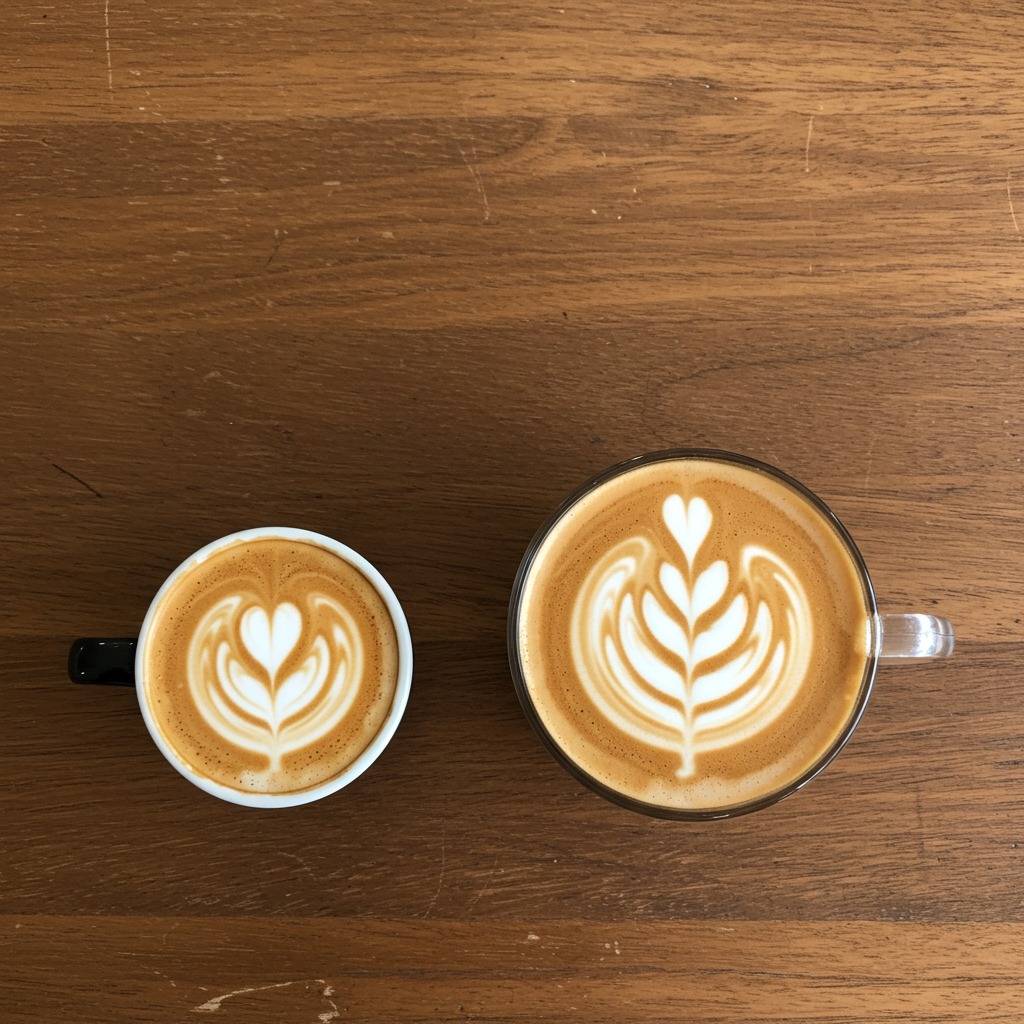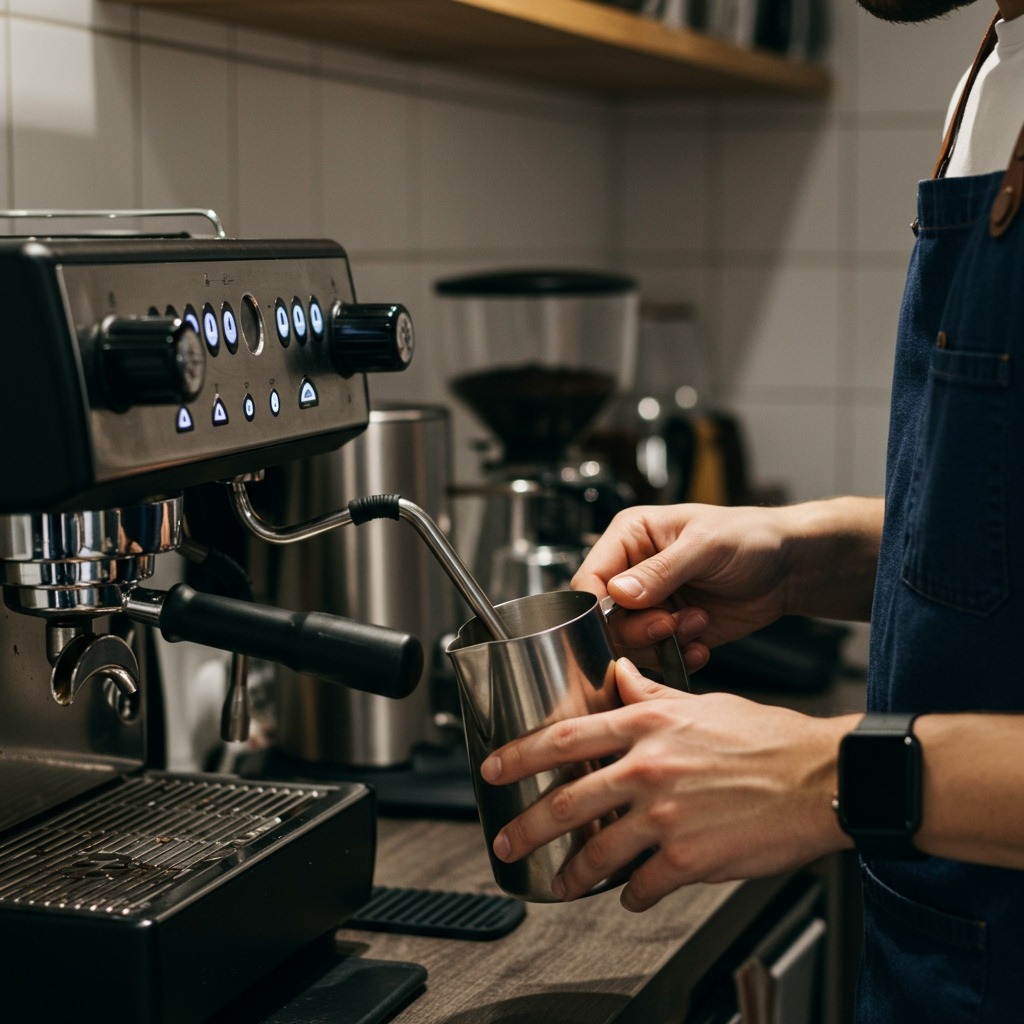You step up to the counter, eyes scanning the familiar yet perplexing coffee menu. “Flat white… latte…” The names whisper promises of caffeinated bliss, but a nagging question hangs in the air. Flat white or latte? They sound so similar, built from the same core ingredients of espresso and milk. But are they truly interchangeable? What’s the real story behind these popular choices, and how do you pick the one that will actually hit the spot?
If you’ve ever felt this flicker of indecision, you’re not alone. The world of espresso drinks can be nuanced. But fear not! This guide is here to demystify the flat white vs latte discussion. We’ll break down their origins, ingredients, and the subtle yet significant differences in preparation that lead to distinct tasting experiences. By the end, you’ll not only understand the difference but also be equipped to confidently order—or even craft—your perfect cup. While both start with the magic of espresso and the comfort of steamed milk, the true artistry lies in the details.
The Building Blocks: Understanding Espresso and Steamed Milk
Before we pit these two coffee titans against each other, let’s get familiar with their fundamental components. After all, a masterpiece is only as good as its materials.
A. Espresso Essentials
At the heart of both a flat white and a latte is a shot (or two) of espresso. But what exactly is espresso? It’s a concentrated coffee beverage brewed by forcing a small amount of nearly boiling water under pressure through finely-ground coffee beans.1 This process extracts a rich, intense flavor and a syrupy body, topped with a reddish-brown foam called “crema.”
The character of your espresso dramatically influences the final drink:
- The Shot: A single shot is standard, but a double shot (doppio) provides a more robust coffee flavor. Some drinks, particularly the flat white, might even use a ristretto shot. A ristretto is a “restricted” shot, using less water for the same amount of coffee, resulting in a shorter, more concentrated, and often sweeter extraction. The journey of your coffee often begins with decisions about how to roast coffee beans to bring out their best qualities, followed by learning how to grind coffee beans to the perfect consistency for espresso.
- Bean Quality: The type and roast level of coffee beans used are paramount. High-quality, freshly roasted beans make a world of difference.
B. The Art of Milk Steaming
Steamed milk is the other crucial half of these beverages, but not all steamed milk is created equal. The texture of the milk is arguably the most significant differentiator in the flat white vs latte showdown.
- Microfoam: This is the gold standard for many espresso drinks, especially the flat white. It’s created by introducing a small amount of air into the milk while steaming, then continuing to heat and swirl it to create a smooth, velvety texture reminiscent of wet paint. The bubbles are so tiny they are barely perceptible, resulting in a liquid that integrates perfectly with the espresso, enhancing its flavor and creating a luxurious mouthfeel.
- Frothed Milk/Thicker Foam: For lattes, baristas often incorporate more air into the milk during the initial phase of steaming (called “stretching”). This creates a lighter, airier foam that forms a distinct layer on top of the drink. While still creamy, it has a more substantial, foamy cap compared to the integrated microfoam of a flat white.
Understanding these nuances in milk preparation is key to appreciating why a flat white and a latte, despite their shared DNA, offer such different sensory experiences.
Side-by-side comparison showing two milk textures – one showing velvety microfoam (flat white style) and one showing thicker foam (latte style) in glass pitchers, demonstrating the visual difference in milk preparation techniques – clean, instructional lighting
Defining the Drinks: What is a Flat White? What is a Latte?
Now that we’ve covered the basics, let’s formally introduce our contenders.
A. The Flat White Unveiled
The flat white is a drink that commands respect for its elegant simplicity and coffee-forward profile.
- Origin Story: While its exact birthplace is hotly debated between Australia and New Zealand, it emerged in the 1980s as a response to the overly foamy cappuccinos of the time. Coffee drinkers sought a milk-based drink that still allowed the quality of the espresso to shine through.
- Core Characteristics: The flat white is defined by a strong espresso presence, complemented by a thin, almost glossy layer of silky microfoam. It’s typically served in a smaller ceramic cup (around 5-6 ounces or 150-180ml).
- Espresso Base: Traditionally, a flat white features a double shot of espresso, often ristretto shots, to give it that characteristic intensity relative to the smaller volume of milk.
- Milk: The milk is steamed to create that signature velvety microfoam, which is then poured to integrate seamlessly with the espresso, creating a harmonious blend from the first sip to the last. There’s no thick, distinct cap of foam.
- Presentation: Latte art on a flat white is usually minimal – perhaps a simple dot or a delicate rosetta – as the focus is on the unified texture and the rich color of the coffee shining through the thin milk layer.
B. The Classic Latte Explained
The latte, or caffe latte, is a globally beloved coffeehouse staple, known for its comforting creaminess. If you want a deep dive specifically into this drink, you can explore more about latte coffee.
- Origin Story: The term “caffe latte” is Italian, literally meaning “milk coffee.” While Italians have been mixing coffee and milk for generations, the modern cafe latte as we know it, with its specific proportions and foamed milk, gained international popularity alongside the rise of espresso culture.
- Core Characteristics: A latte is generally milkier and milder in coffee flavor compared to a flat white, though this can vary based on the number of espresso shots used. Its hallmark is a noticeable layer of creamy foamed milk on top.
- Espresso Base: Lattes typically start with one or two shots of standard espresso. The larger volume of milk naturally dilutes the espresso flavor more than in a flat white.
- Milk: The milk for a latte is steamed to create a greater volume of froth. While it should still be creamy, there’s a more pronounced distinction between the liquid steamed milk and the cap of foam.
- Presentation: Lattes are often served in a larger glass or mug (8 ounces or 240ml, often much larger in many US coffee chains) and provide a broader canvas for more elaborate latte art, thanks to that thicker foam layer.
Flat White vs Latte: The Head-to-Head Comparison
Let’s break down the key differences side-by-side to make it crystal clear:
| Feature | Flat White | Latte (Caffè Latte) |
| Espresso Strength | Stronger, coffee-forward; often double ristretto or double espresso | Milder; typically single or double espresso |
| Milk Texture | Velvety microfoam, fully integrated | Steamed milk with a distinct layer of frothed foam |
| Amount of Milk | Less milk overall | More milk overall |
| Foam Layer | Very thin (approx. 0.5 cm or ¼ inch), “flat” | Thicker (approx. 1 cm or ½ inch, can be more) |
| Coffee-to-Milk Ratio | Higher coffee ratio | Higher milk ratio |
| Serving Size/Cup | Smaller (typically 5-6 oz / 150-180 ml ceramic cup) | Larger (typically 8+ oz / 240+ ml glass or mug) |
| Taste Profile | Intense coffee flavor, smooth, rich body | Milder coffee flavor, creamier, milk-forward |
| Latte Art | Minimal, often a simple dot or subtle design | More common and can be elaborate |
| Origin | Australia / New Zealand (1980s) | Italy (older, but modern form evolved with espresso culture) |
This table should give you a quick snapshot, but the true understanding comes from tasting and experiencing the distinct textures.
Why the Confusion? Overlaps and Café Variations
If you’re still thinking, “But sometimes my latte looks like a flat white!” – you’re not wrong to be confused. The lines can blur.
- Café Interpretation: Not every café adheres strictly to traditional definitions. Some may serve a “latte” that has very well-textured microfoam, making it seem closer to a flat white, just in a larger cup. Conversely, a poorly made flat white might have too much foam. This is particularly true if you’re comparing a specialty coffee shop with a more mainstream chain.
- The “Third Wave” Influence: The rise of “third wave” coffee culture (a movement focusing on high-quality, artisanal coffee) has brought more precision to drink preparation. Baristas in such establishments are often meticulously trained in milk texturing, leading to more distinct flat whites. You can learn more about coffee’s journey and appreciation through resources like the Specialty Coffee Association (SCA), which offers extensive educational content.
- The “Wet” Cappuccino Effect: Sometimes, a latte made with excellent microfoam can resemble what’s known as a “wet” cappuccino (a cappuccino with less airy foam and more liquid steamed milk).
- Chain Standardization: Large coffee chains, like Starbucks (whose interpretation is the #1 SERP result), standardize their recipes globally. Their flat white, for instance, specifically uses ristretto shots and a signature microfoam dot. While this brings consistency, it might differ slightly from the drink’s original incarnation or how it’s served in independent cafes.
Which One Should You Choose? A Flavor Seeker’s Guide
Ultimately, the best drink is the one you enjoy most. Here’s a simple guide to help you navigate your next coffee decision in the flat white vs latte dilemma:
Choose a Flat White if:
- You crave a robust, distinct espresso flavor that isn’t masked by too much milk.
- You appreciate a smooth, velvety texture throughout the drink, without a cap of dry foam.
- You prefer a more concentrated, typically smaller, coffee experience.
- You want the coffee itself to be the star of the show.
Choose a Latte if:
- You enjoy a milder, creamier coffee experience where the milk plays a more prominent role.
- You love that comforting, warm drink with a distinct layer of soft, spoonable foam on top.
- You prefer a larger beverage to sip on for a longer time.
- You’re looking for a gentler introduction to espresso drinks.
Don’t be afraid to experiment! Try a flat white from a café known for its coffee quality, and then try their latte. Notice the differences in texture, strength, and overall feel. Your personal preference is what matters most.
Beyond Flat White vs Latte: Exploring Similar Espresso Drinks
Understanding the flat white and latte opens the door to appreciating other members of the espresso-and-milk family. Each has its own unique character:
- Cappuccino: Often confused with lattes, a traditional cappuccino has roughly equal parts espresso, steamed milk, and a thicker, airier cap of foam than a latte. The texture of the foam is typically drier.
- Macchiato: An espresso “stained” or “marked” with a small dollop of steamed milk or foam. It’s much smaller and more coffee-intense than either a flat white or latte.
- Cortado: Hailing from Spain, the cortado coffee features espresso “cut” with an roughly equal amount of warm, steamed milk (not overly foamy, often similar in texture to flat white milk but with less total milk). It’s served in a small glass, typically around 4-5 oz.
- Breve: For an even richer experience, consider a breve coffee. This is an American variation of a latte made with steamed half-and-half (a blend of milk and cream) instead of milk, resulting in a very decadent and creamy drink.
Knowing these relatives helps you better place the flat white and latte within the broader spectrum of coffee delights.
Making Them at Home: Tips for the Aspiring Barista
Want to try your hand at crafting these café favorites in your own kitchen? It’s a rewarding skill to develop!
- Espresso First: A good quality espresso is non-negotiable. While a dedicated espresso machine is ideal, you can get a strong coffee base using a Moka pot or an AeroPress. It won’t be true espresso, but it can be a good starting point. Remember that the difference between espresso and coffee made by other methods is significant in terms of concentration and texture.
- Milk Steaming Finesse: This is where the magic (and challenge) lies:
- For a Flat White (Microfoam): You want to introduce minimal air. Keep the steam wand tip just below the surface of the milk to create a gentle whirlpool. The goal is silky, paint-like milk. Avoid loud hissing or bubbling sounds.
- For a Latte (Frothed Milk): You’ll “stretch” the milk more by keeping the steam wand tip closer to the surface for the first few seconds to incorporate more air, creating that thicker foam layer. Then, submerge the wand to heat the milk to the desired temperature.
- Invest in a Good Pitcher: A stainless steel milk steaming pitcher with a spout is essential.
- Practice, Practice, Practice: Don’t get discouraged if your first few attempts aren’t perfect. Milk steaming takes time and patience to master. Watch videos, and pay attention to the sound and feel. You might even find that a simpler preparation, like learning how to make French press coffee, is enjoyable while you hone your barista skills.
The Global Appeal & Evolution of Espresso Drinks
From their respective birthplaces, both the flat white and the latte have embarked on a global journey, becoming staples in cafes from Sydney to Seattle, London to Lisbon. This worldwide adoption is a testament to their appealing balance of coffee and milk. The ongoing evolution of coffee culture continues to refine and sometimes redefine these drinks, with baristas and coffee enthusiasts constantly pushing the boundaries of quality and creativity. Whether you prefer a traditional drip coffee or a complex espresso creation, the shared language of coffee brings people together.
The subtle dance between precisely extracted espresso and perfectly textured milk is what elevates these beverages from mere caffeine delivery systems to daily moments of pleasure. Understanding the flat white vs latte distinction enriches your coffee experience, allowing you to choose (or create) the cup that perfectly matches your mood and preference.
FAQ: Flat White vs Latte
Q1: Is a flat white stronger than a latte?
A: Generally, yes. A flat white typically has a higher coffee-to-milk ratio, often using double shots or ristretto shots in a smaller volume, leading to a more intense and coffee-forward flavor compared to the milkier latte.
Q2: Which has more milk, a flat white or a latte?
A: A latte has significantly more milk than a flat white. Lattes are larger drinks overall, with the additional volume primarily coming from steamed milk and a thicker layer of foam.
Q3: Can I get a flat white or latte with almond milk (or other plant-based milks)?
A: Absolutely! Most cafes offer a variety of plant-based milk alternatives like almond, soy, oat, or coconut milk. However, be aware that different plant-based milks steam differently. Oat milk, for example, often creates a microfoam texture very similar to dairy milk, making it a popular choice for flat whites. Almond and soy milk can also be steamed well, but the texture might be slightly different.
Q4: What is a “ristretto” shot and why is it often used in flat whites?
A: A ristretto shot is an espresso shot that is “restricted,” meaning it’s pulled with the same amount of coffee grounds but about half the amount of water as a standard espresso shot. This results in a more concentrated, sweeter, and less bitter shot with a fuller body. It’s often used in flat whites to provide a strong coffee flavor that punches through the milk without adding too much liquid volume.
Q5: Is a flat white just a small latte without the foam?
A: Not quite. While a flat white is smaller and has minimal foam, the key distinctions lie in the milk texture and the coffee-to-milk ratio. A flat white uses velvety microfoam that is thoroughly integrated with the espresso, creating a consistent texture from top to bottom. A latte has a thicker layer of more distinct foam on top and a higher proportion of milk overall, leading to a milder taste. The focus of a flat white is a harmonious balance where the espresso shines, whereas a latte is often a creamier, more milk-dominant beverage.




